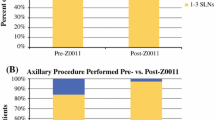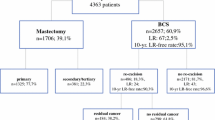Abstract
Background: The current AJCC protocol for breast cancer staging does not include additional tumor found at the time of re-excision in the calculation of tumor size. We hypothesize that the AJCC protocol may result in understaging and undertreatment of breast cancer patients who have additional tumor found at re-excision.
Methods: In a retrospective chart review of breast cancer patients, patients with tumor present at re-excision for positive margins were placed in group 1 (n=72); patients with no tumor present at re-excision, or who underwent a single, negative margin procedure were placed in group 2 (n=147).
Results: Patients in group 1 had a higher risk of nodal metastases when compared to patients in group 2. Mean tumor size did not differ significantly between the subgroups. Positive re-excision was strongly associated with lymph node metastases on multivariate analysis after correction for age, grade, stage, and lymphatic invasion (odds ratio=3.13, 95% CI=1.58 6.18,P=.0011).
Conclusions: Current AJCC guidelines may result in undertreatment of breast cancer patients with positive re-excisions. The presence of additional tumor at the time of re-excision should be considered when determining the need for systemic therapy, and may be relevant in determining T stage.
Similar content being viewed by others
References
Brenin DR, Morrow M. Conventional axillary dissection: extent, local control, and morbidity.Semin Breast Dis (in press).
Cady B. Case against axillary lymphadenectomy for most patients with infiltrating breast cancer.J Surg Oncol 1997;66:7–10.
Barth A, Craig PH, Silverstein MJ. Predictors of axillary lymph node metastases in patients with T1 breast carcinoma.Cancer 1997;79:1856–64.
Wong JS, Recht A, Beard CJ, et al. Treatment outcome after tangential radiation therapy without axillary dissection in patients with early-stage breast cancer and clinically negative axillary nodes.Int J Rad Oncol Biol Phys 1997;39:915–20.
Silverstein MJ, Gierson ED, Waisman JR, Senofsky GM, Colburn WJ, Gamagami P. Axillary lymph node dissection for T1a breast carcinoma. Is it indicated?Cancer 1994;73:664–7.
American Joint Committee on Cancer. Breast. In: Fleming ID, Cooper JS, Henson DE, et al., eds.Manual for Staging of Cancer. 5th ed. Philadelphia: Lippincott-Raven, 1997:171.
Bloom HJ, Richardson WW. Histological grading and prognosis in breast cancer.Br J Cancer 1957;11:359–77.
Scarff RW, Torloni H.Histological Typing of Breast Tumors. Geneva: WHO; 1968:13–20.
SAS Institute Inc.SAS/STAT User's Guide. Version 6, 4th ed. Cary NC: SAS Institute, 1989.
Hosmer DW Jr, Lemeshow S.Applied Logistic Regression. New York: John Wiley & Sons; 1989.
Haagensen CD, Stout AP. Carcinoma of the breast: results of treatment.Ann Surg 1944;116:801–15.
Nemoto T, Vans J, Bedwani RN, Baker HW, McGregor FH, Murphy GP. Management and survival of female breast cancer: Results of a national survey by the American College of Surgeons.Cancer 1980;45:2917–24.
Ravdin PM, DeLaurentiis M, Vendely T, Clark GM. Prediction of axillary lymph node status in breast cancer patients by use of prognostic indicators.J Natl Cancer Inst 1994;86:1771–5.
Fisher B, Slack NH, Bross IDJ. Cancer of the breast: size of neoplasm and prognosis.Cancer 1969;24:1071–80.
Reger V, Beito G, Jolly PC. Factors affecting the incidence of lymph node metastases in small cancers of the breast.Am J Surg 1989;157:501–2.
Carter CL, Allen C, Henson DE. Relation of tumor size, lymph node status, and survival in 24,740 breast cancer cases.Cancer 1989;63:181–7.
Holland PA, Walls J, Boggis CRM, Knox F, Baildam AD, Bundred NJ. A comparison of axillary node status between cancers detected at the prevalence and first incidence breast screening rounds.Br J Cancer 1996;74:1643–6.
Halverson KJ, Perez CA, Myerson R, Levy J, Tucker G. Management of the axilla in patients with breast cancers one centimeter or smaller.Am J Clin Oncol 1994;17:461–6.
Robbins GF, Berg JW. Bilateral primary breast cancers: a prospective clinicopathological study.Cancer 1964;17:1501–27.
Say CC, Donegan WL. Invasive carcinoma of the breast: prognostic significance of tumor size and involved axillary nodes.Cancer 1963;16:1589–97.
Fisher ER, Gregario RM, Fisher B, et al. The pathology of invasive breast cancer: a syllabus derived from findings of the National Surgical Adjuvant Breast Project (Protocol No 4).Cancer 1975;36:1–85.
Rosen PP. Invasive mammary carcinoma. In: Harris JR, Lippman ME, Morrow M, Hellman S, eds.Diseases of the Breast. Philadelphia: Lippincott-Raven, 1996;393–444.
Seidman JD, Schnaper LA, Aisner SC. Relationship of the size of the invasive component of the primary breast carcinoma to axillary lymph node metastasis.Cancer 1995;75:65–71.
Author information
Authors and Affiliations
Rights and permissions
About this article
Cite this article
Brenin, D.R., Morrow, M. Accuracy of AJCC staging for breast cancer patients undergoing re-excision for positive margins. Annals of Surgical Oncology 5, 719–723 (1998). https://doi.org/10.1007/BF02303483
Received:
Accepted:
Issue Date:
DOI: https://doi.org/10.1007/BF02303483




